Legendary yachtsman Jakob Isbrandtsen was competing in Cowes Race Week in 1963 when an idea came to him. It was a cold, rainy, windy day on the waters surrounding the Isle of Wight and Isbrandtsen was reveling in the conditions while at the helm of Windrose, his Sparkman & Stephens 47-foot yawl. Isbrandtsen turned to his navigator Victor Romagna and made a declaration.
“Victor, this is so damn fun. We should have a regatta like this back home,” he said.
That statement ultimately gave birth to Block Island Race Week, one of the most historic iconic events held in the United States. First held in 1965 and organized by the Storm Trysail Club, the five-day regatta has routinely attracted some of the best boats and sailors along the Eastern Seaboard and beyond.
Storm Trysail Club is celebrating a special anniversary in 2023 as this will be the 30th edition of Block Island Race Week. To commemorate the occasion, we take a look back at the early days of the biennial regatta, which quickly built a reputation for delivering exciting competition on the water and loads of fun ashore.
Isbrandtsen was a longtime member of the Storm Trysail Club and a past commodore. Naturally, he turned to that organization to make the vision of holding a version of Cowes Race Week in the United States a reality.
In order to replicate Cowes Race Week, the original organizers settled on conducting the fledgling regatta from an island. Block Island was chosen over Nantucket and Martha’s Vineyard, a decision no doubt influenced by the fact Storm Trysail Club had great familiarity with the location. That’s because the organization was already running the Block Island Race, which started and finished in Larchmont, New York.
Isbrandtsen enlisted Everett Morris and Vincent Monte-Sano to serve as chairman and vice chairman of the proposed regatta and those two men traveled to Block Island to meet with Paul Filippi, a locker power broker. Filippi had originally gone to Block Island to secure land in anticipation of casinos being approved by Rhode Island. He fell in love with the town of New Shoreham and stayed, opening Ballard’s Restaurant after the casino business never materialized.
Filippi gave his blessing to the week-long sailboat racing regatta idea and used his influence to ensure other local businesses supported it. In those days, the tourist season on Block Island did not get going until July 4, so all agreed the regatta should be held in mid-June during the slow part of the summer.
At the time, Block Island had no paved roads and very few retail stores. There were about 300 full-time residents and most of the visitors were either bikers or fishermen. There was only one cab driver named Rosie. Needless to say, it was a bit of a shock to the locals when 175 boats and some 1,200 sailors descended upon the sleepy island for the inaugural Block Island Race Week in 1965.
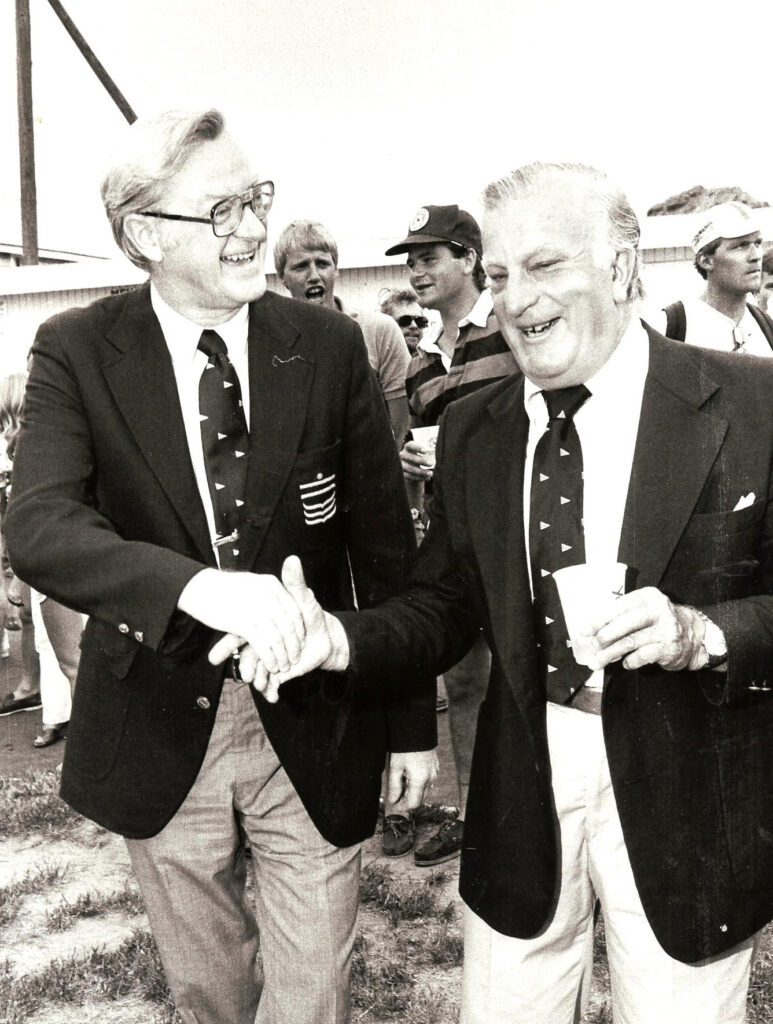
Everett Morris, the regatta’s first chairman, was well known as the yachting writer for the New York Herald Tribune. Vincent Monte-Sano, the vice chairman, was a clothier operating the family-owned business Monte-Sano and Pruzan on West 46th Street in New York City.
Other key members of the original regatta committee included Jack Brown (secretary), Arthur Wullschleger (finance), Joseph Wise (entertainment), Leo Bombard (prizes), Paul Hoffman (harbor services) and Romagna (liaison with flag officers). Lewis Proudfoot was chairman of the on-water race committee.
A large majority of the boat owners competing in the first Block Island Race Week hailed from western Long Island Sound. However, many other boats came from as far away as Florida along with Maine and the Chesapeake Bay region.
On the water, that inaugural regatta was somewhat of a bust due to foggy conditions that prevailed throughout the week. Due to the combination of dense fog and light winds, only three races were completed over six days.
However, the social scene onshore and raucous afternoon parties made the Block Island Race Week a rousing success. It returned in 1967 and has been held every two years ever since. The regatta has always been held in odd years so as not to conflict with the Newport Bermuda Race.
Inverness, an S&S 47 owned by Robert McCullough of Riverside, Connecticut, won all three races in Class B and was second overall on corrected time in the Round the Island Race. McCullough was presented with the Outstanding Performance Trophy, which would two years later be named in honor of Morris.
Geronimo, owned by James Grove of New York was the Class A winner at the first Block Island Race Week. Bill Tripp, who designed the 53-footer, served as helmsman aboard Geronimo.
Many other well known and highly successful boats would make the trek to subsequent editions of Block Island Race Week. Renowned sailmaker and Naval architect Ted Hood sailed a series of boats named Robin at the regatta, winning Class A in 1967 with a 50-footer he designed and six years later winning Class E and the Morris Trophy with a smaller boat.

Highly-successful shipbuilder and boatyard owner Robert Derecktor was a regular participant during the early years. Derecktor, who built many of the America’s Cup 12-meters, captured Class A at the 1969 Block Island Race Week aboard Wild Goose, an aluminum 55-footer of his own design.
That was the same year Isbrandtsen took first place overall in the Round the Island Race aboard Good News, an S&S 68. Isbrandtsen, a Riverside, Connecticut resident, had a loyal crew the core of which consisted of hardy men who had been members of the Offshore Patrol. Romagna, Jim Moore, Donald Browning and Joe Burbeck were among those recruited to use sailing yachts to patrol 10-mile grids of the Atlantic Ocean searching for German submarines.
Those same men crewed for Bus Mosbacher aboard America’s Cup winners Weatherly and Intrepid.
COLORFUL CHARACTERS
Rich du Moulin and Vince “Bizzy” Monte-Sano III, two current Storm Trysail Club members and sons of Block Island Race Week legends, had the pleasure of racing with Isbrandtsen as young men. Du Moulin was aboard Good News in 1969 and remembers well one of the most infamous pranks ever pulled at Block Island Race Week.
It was an era when Good News had a serious rivalry with Thunderhead, a Rhodes 58 owned by Paul Hoffman. Dr. Les Commons, a dentist from Fort Washington, New York who was the cook aboard Good News, grabbed one of the geese that patrolled the property of the local constable.
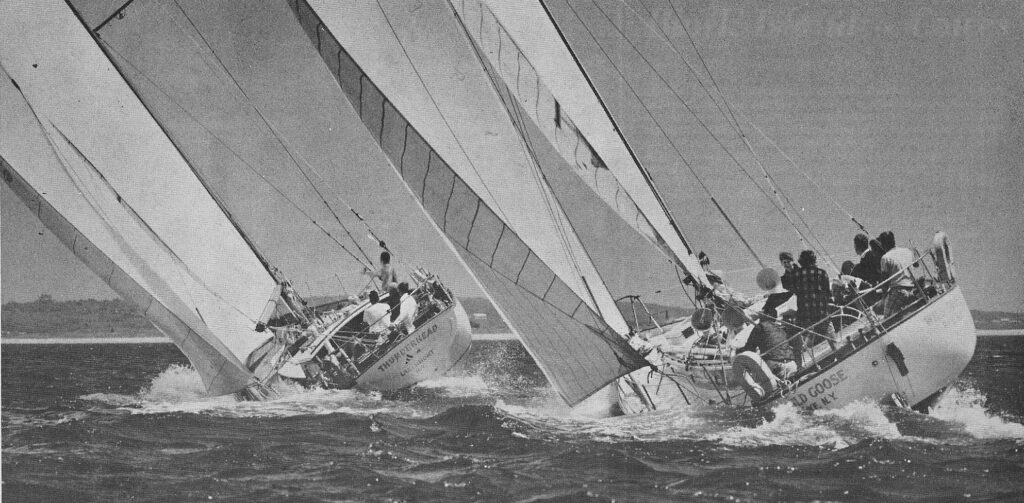
Commons then smuggled the goose onto Thunderhead under the cloak of darkness and threw it down the hatch into the cabin. When the Thunderhead crew arrived the next morning to get the boat ready for racing, they discovered the goose had made a complete mess of the cabin in numerous ways.
“The Thunderhead guys knew immediately that Les Commons was responsible and were walking the docks looking for him,” du Moulin said. “Les knew they would be made, so he never showed up at the dock. He got out to the racecourse by hitching a ride aboard Illusion.”
There were plenty of hijinks during the early editions of Block Island Race Week. A group of sailors once snatched a horse out of a pasture and brought it down to the docks at Champlin’s Marina with the intent of loading it onto a rival’s boat. However, the horse was uncooperative and things went awry during the boarding attempt with the animal falling into the water. Fortunately, the incident ended well with the horse swimming across the Great Salt Pond and made it safely ashore.
From the outset, the tone and tenor of Block Island Race Week was set: race hard on the water, party and play hard onshore. Storm Trysail Club organizers built in an automatic lay day mid-week to ensure the sailors blew off some steam. A series of games were organized with teams competing in a series of events to score points. There were tug-of-war battles and an outrageous jousting competition in Champlin’s pool.

Nick and Penny Langone were there from the outset and know all the stories. One of the real characters was Jane Mansfield, who ran the duty office and had control of a microphone. Hidden from view, Mansfield was famous for saying outrageous things on the loudspeaker, such as “Vinny Monte-Sano, we found your underwear in the graveyard. Please come pick it up.”
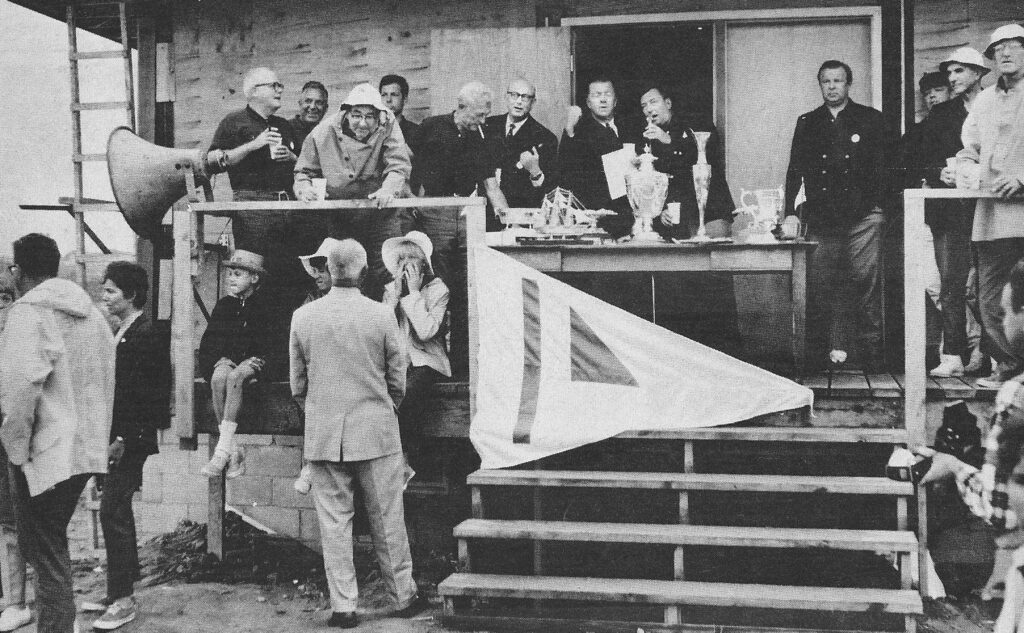
It was Mansfield who gave life to a fictitious character named Dr. Willi Faraguli, who was purported to be a world renowned ornithologist. She would announce that Dr. Faraguli would be giving a birdwatching tour that afternoon at the Block Island National Wildlife Refuge.
Faraguli’s name was mentioned so many times throughout the week over the years that many visiting sailors thought he was a real person. Things came to a head when a woman from the mainland showed up on Block Island with her prized parrot with the purpose of showing the rare bird to the expert ornithologist she’d heard so much about.
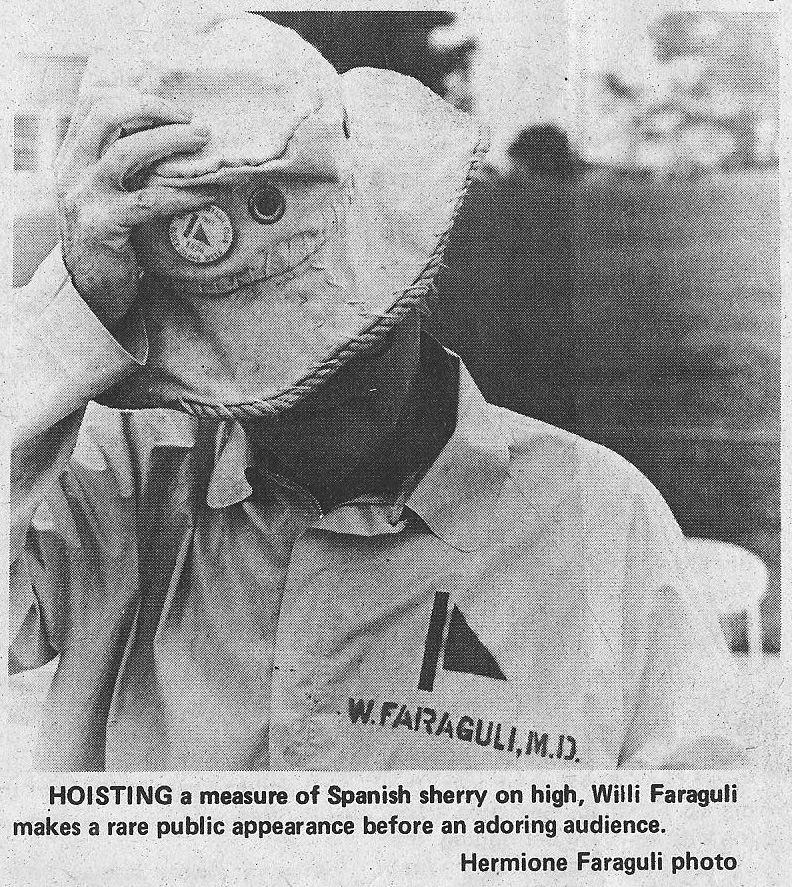
By 1981, there was a Willi Faraguli Perpetual Trophy presented to the Storm Trysail Club member who demonstrates the greatest level of “Decency Under Duress.”
Vincent Monte-Santo Jr. co-owned a Cal 40 named Illusion along with Bus Mosbacher and it was quite successful. They explained the genesis of the name was the boat’s speed, often using the catch phrase “Now you see it, now you don’t.” (Fun fact: that very same Cal 40 won the 2022 Newport Bermuda Race in last year skippered by Storm Trysail Club member's Stan and Sally Honey).
Penny Langone, who is Monte-Sano’s daughter, remembers a rival crew once adding a D in front of the name of the storm of the boat. Nobody noticed and the Cal 40 spent a day racing under the derisive name.
Beginning in 1967, a special prize known as the Blockhead Trophy was presented to an unfortunate individual who was responsible for an embarrassing seamanship mistake or some other type of notable transgression.
Edward du Moulin and Harold Oldak were co-owners of a Carter 39 known as Blaze that dominated Class C in the 1975 edition of Block Island Race Week. They sailed Blaze to victory in four races and a runner-up result in the other, easily beating sister ship Love Machine and earning the Morris Trophy as Boat of the Week.
Oldak and du Moulin brought the boat back to Block Island in 1979 and had a severe mishap at the start of Race 1. Arriving early at the leeward end of the line, they purposefully luffed the sails to reduce speed. That move proved disastrous as Blaze lost momentum and got pushed down on the wire cable anchor line of the committee boat. The cable went between the keel and the rudder and in the ensuing mayhem the bowsprit went through the brand new genoa.
“We went out the next day with bags over our heads,” Rich du Moulin recalled. “What a turnaround. We went from winning the Morris Trophy to getting the Blockhead Trophy.”

Jim Kilroy was unanimous winner of the Blockhead Trophy in 1981. He brought the 80-foot maxi Kialoa III to Block Island and finished third in Class A, but not before committing a terrible gaffe.
Upon learning that Kialoa III had a 12-foot keel, organizers with Storm Trysail Club warned Kilroy not to go out the main channel at low tide. He did exactly that and the S&S 80 ran hard aground, blocking the entire channel and causing a two-hour postponement.
There was concern the 1971 Block Island Race Week would have to be canceled due to a nationwide gas shortage that still ranks among the most severe in United States history. A high-ranking member of the Storm Trysail Club contacted Rhode Island governor Frank Licht, who assured there would be gas available on Block Island during the regatta.
SUCCESSFUL SYNDICATES
Charles “Butch” Ulmer was introduced to Block Island Race Week in 1967 as crew aboard a Tripp 38 owned by Bill Heine. He would return many more times as part of an ownership group that included Pat O’Neal, Howard McMichael, Joseph Fontanella and Jack Westin.
They called it the A.M.B. Syndicate with the acronym standing for “Atsa My Boat” and raced a series of boats named Puff — a Ranger 33 in 1971, a Ranger 37 in 1973 and a Tartan 41 in 1975. Puff won Class E and was presented with the Morris Trophy in 1971 then won Class D in 1973.
Ulmer recalled the regatta was more of a social event in the early years and that message was sent by organizers who ran just one race per day using government marks. There was effort put into setting a square course. STC would anchor the committee boat just outside the Great Salt Pond and that is where racing started and ended regardless of wind direction.
Fog, which was jokingly referred to as Block Island Sunshine, was a perpetual issue in an era when the only electronic navigation aboard sailboats was a direction finder.
“You needed a really knowledgeable and experienced navigator to sail around Block Island,” said Ulmer, longtime president of the family sailmaking company founded by his father.
Fortunately, the A.M.B. syndicate had one in Fontanella during the 1971 Round the Island Race. Halfway through the race, the fog rolled in and the bow of the boat was barely visible from the cockpit.
“Somehow, Joe found his way around the island and when we came into the clear there were no other boats to be seen. The entire fleet was lost in the fog,” Ulmer said.
In the early days, most crews slept aboard the boats with a fortunate few finding rooms at the Narragansett Inn atop the hill overlooking The Oar. Regatta headquarters was initially at Champlin’s with post-race parties held inside a giant circus-style tent erected on the grounds. Ulmer recalls a Dixieland band playing inside the tent every day.
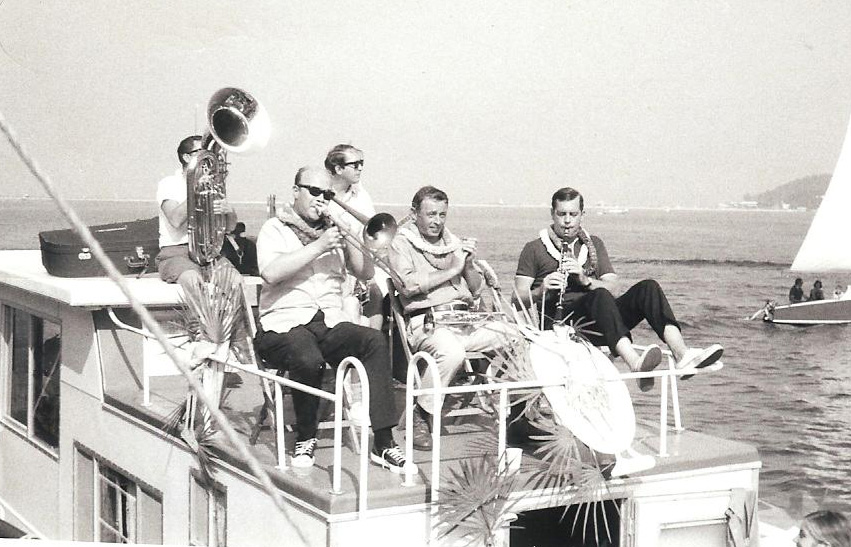
Boats were berthed at Champlin’s, Payne’s Dock and Block Island Boat Basin. While The Oar would later become famous with visiting sailors for its Mudslides, the specialty drink of the house in the 1970s was a Clamdigger — vodka with tomato juice and clam juice.
Ulmer, who estimates he’s competed in 20 editions of Block Island Race Week and one time served as on-water chairman, acknowledged that even the most serious sailboat racers engaged in some “shenanigans” during the regatta. He recalled one race when Puff had a slim lead over several pursuing class rivals during a light air race. Members of the crew had a box of cherry bombs, which they lit and threw in the direction of the trailing boats.
The inaugural Block Island Race Week in 1965 featured six classes (A through E and MORC). By 1981, the number of classes had grown to 12 (A through K and MORC). However, there was a fundamental change two years later when the 10 competing classes were split among boats racing under the International Offshore Rule (IOR) and the Measurement Handicap System (MHS) handicap system.
There is a long list of skippers and boats that enjoyed tremendous sustained success at Block Island Race Week during that period. Isbrandtsen brought his brand new, custom-designed Sparkman & Stephens 61 to the 1971 edition and dominated Class A. That boat was named Running Tide and would become one of the most iconic offshore racers on the East Coast.
Isbrandtsen also won the 1970 Newport Bermuda Race and the 1971 Southern Ocean Racing Circuit aboard Running Tide. Billionaire businessman and America’s Cup winning skipper Ted Turner leased the sleek black racer for six months and further impressive performances sparked a bidding war for the boat between Turner and northern Virginia real estate developer Al Van Metre.
Van Metre ultimately won and brought Running Tide back to Block Island Race Week in 1973 and she once again captured Class A. Other well-known winners of Class A (which comprised the largest boats) included the aforementioned Thunderhead (1975), the S&S 45 Tatoosh (Bob Barton, 1977) and the S&S 49 Scaramouche (Chuck Kirsch, 1979).
Toward the end of the first 20-year cycle of Block Island Race Week, another breakthrough design wowed everyone on the water with its high performance. John B. Thomson Jr., a past Storm Trysail Club commodore, commissioned a Nelson-Marek 47 named Infinity that rolled through Class A and captured consecutive Morris Trophy honors in 1981 and 1983.
Other boats that captured class honors in multiple editions of Block Island Race Week from 1965 to 1985 included Scorpion (Tripp 42, Jack Sutphen), Wings (Soveral 33, William Soveral), Love Machine (Carter 39, Dick Hokin), Not By Bread Alone (Peterson 35, William Donovan) and Elixir (David Noyes).
While the trophies have been passed around over the years, everyone who participates in Block Island Race Week agrees, it is much more than a competition that draws back thousands of sailors every two years. The camaraderie and atmosphere on the small island off the smallest state the third week in June every two years is a special time that holds a special place in many-a-sailor's heart.
Results 1965-1985
BLOCK ISLAND RACE WEEK CLASS WINNERS
1965
- Class A: Geronimo, James Grove
- Class B: Inverness, Robert McCullough
- Class C: Storm, E. Luders Jr., Stamford, Connecticut
- Class D: Pursuit, R.F. Sheehan
- Class E: Freebooter, A. Widmann
- MORC: Jack Rabbit, R. Heinzerling
- Around Block Island Race Winner: Julie, Paul Campbell
- Outstanding Performance Trophy: Inverness, Robert McCullough
1967
- Class A: Robin, Hood 50, Ted Hood
- Class B: Windquest, Justin Weisley
- Class C: We’re Here, Allan Watkins
- Class E: Pinkletink, Howard E. Foster
- MORC: Renegade, Bill Baxter
- Around Block Island Race: Wild Goose, Bob Derecktor
- Everett B. Morris Memorial Trophy for Best Overall Performance: Pinkletink, Howard Foster
1969
- Class A: Wild Goose, Bob Derecktor
- Class B: Inverness, Robert McCullough
- Class C: Scorpion, Tripp 42, Jack Sutphen, Larchmont
- Class D: Shearwater, T.R. Young
- Class E: Ergo, Conrad Jones
- MORC: Wings, William Soveral,
- Around Block Island Race: Good News, Jakob Isbrandtsen
- Everett B. Morris Memorial Trophy For Best Performance Overall: Ergo, Conrad Jones
1971
- Class A: Running Tide, Jakob Isbrandtsen,
- Class B: Gem, William Ziegler,
- Class C: Resistance, SUNY Maritime
- Class D: Alethea, Melvin Holstein
- Class E: Puff, A.M.B Syndicate
- Class F: Syrinx, Ralph Lawson
- MORC: Wings, William Soveral,
- Around Block Island Race: Puff, Butch Ullmer, Atsa My Boat, A.M.B. Syndicate
- Everett B. Morris Memorial Trophy For Best Performance Overall: Puff, A.M.B. Syndicate
1973
- Class A: Running Tide, A.G. Van Metre
- Class B: Gem, William Ziegler,
- Class C: Golliwogg, Golliwog Syndicate
- Class D: Puff, A.M.B. Syndicate
- Class E: Robin, Ted Hood
- Class F: Scorpion, Jack Sutphen
- Class G: Rhubarb, Benjamin DuPont
- MORC 1: Sue, Sue, T.M. Russell
- MORC II: Tonto, Donald J. Owler
- Around the Island Race: Robin, Ted Hood
- Everett B. Morris Memorial Trophy For Best Performance Overall: Robin, Ted Hood,
1975
- Class A: Thunderhead, Paul Hoffman
- Class B: Robin, Ted Hood
- Class C: Blaze, Carter 39, Edward duMoulin & Harold Oldak
- Class D: Pampero, R. Snowden Andrews
- Class E: Artemis, P. Conrad, Emil & Vincent Monte-Sano
- Class F: Tinker Toy, R. Randle Scarborough
- Class G: Accolade, Peter O’Neill & Bruce Kirby
- Class H: Katrina, J. Nicholas Newman
- MORC: Pointin’ Star, Ben Hall & Robert Evelyn
- Everett B. Morris Memorial Trophy For Best Performance Overall: Blaze, Edward duMoulin & Harold Oldak
1977
- Class A: Tatoosh, Bob Barton
- Class B: Love Machine, Dick Hokin
- Class C: Peregrine, N. Gahm
- Class D: Fun, Tom Closs Senior and Junior
- Class E: Chaos, J. Beasley
- Class F: Obsession, Philip Walters & Leo Hiatrides
- Class G: Patriot, R. Vedovell
- Class H: Hot Flash, J&G Uznis
- Class I: Elixir, D. Noyes
- MORC: Top of the World, Curtis/Johnstone Syndicate
- Everett B. Morris Memorial Trophy For Best Performance Overall: Obsession, Philip Walters & Leo Hiatrides
1979
- Class A: Scaramouche, Chuck Kirsch
- Class B: Love Machine, Dick Hokin
- Class C: Jubilee, A. Fisher
- Class D: Arete, C. Shumway
- Class E: Dorothea, P. Burke
- Class F: Not By Bread Alone, W. Donovan
- Class G: Osprey, G. Martin
- Class H: Stajon, J. Schinto
- Class I: Elixir, D.C. Noyes Jr.
- Class J: Jasper, Danly/Hayes/Shanahan
- MORC: Mr. Hoot, Henry Meilman/Ben Hall/Roger Lowlich
- Everett B. Morris Memorial Trophy For Best Performance Overall: Mr. Hoot, Henry Meilman/Ben Hall/Roger Lowlich
- Isbrandtsen Perpetual Trophy for Best Performance Overall MHS: Elixir, D.C. Noyes Jr.
1981
- Class A: Infinity, J.B. Thomson Jr.
- Class B: Chasseur, Frank Snyder
- Class C: Aries, M. Swerdlow
- Class D: Taniwha, Anderson/Josten
- Class E: Not By Bread Alone, W. Donovan
- Class F: Vita, J. Buongiorno
- Class G: 3 Ring Circus, JET Syndicate
- Class H: Ginch, P. Connor
- Class I: Storm, B. Barnard
- Class J: Roo, K. Yellott
- Class K: Daedalus, S. Haarstick
- MORC: New Wave, Hewitt/Hall
- Everett B. Morris Memorial Trophy For Best Performance Overall: Infinity, J.B. Thomson Jr.
- Isbrandtsen Perpetual Trophy for Best Performance Overall MHS: Storm, Bruce E. Barnard
1983
- Class 1 IOR: Infinity, John B. Thomson Jr.
- Class 2 IOR: Bright Finish, Michael Levin
- Class 3 MHS: Merrimac, Shaw & Johnstone
- Class 4 IOR: Chasing Rainbows, Jeffrey Weinsten
- Class 5 IOR: Lotus, Seymour Kaback
- Class 6 MHS: Pampero, R.S. Andrews
- Class 7 IOR: Cheap Red, Comfort/Cameron
- Class 8 IOR: As Larks Harmoniously, Carlisle Knowlton
- Class 9 IOR: Ginch, Paul Connor
- Class 10 MHS: Elixir, David Noyes
- Everett B. Morris Memorial Trophy For Best Performance Overall IOR: Infinity, John B. Thomson Jr.
- Isbrandtsen Perpetual Trophy for Best Performance Overall MHS: Pampero, R. Snowden “Denny” Andrews Jr.
1985
- Class 1 IOR 1: Blade Runner, Basil R. Twist
- Class 2 MHS 1: Brass Ring, Nicholas Schaus
- Class 3 IOR: Drumbeat, B. Brown/B. Renshaw
- Class 4 IOR: Volition, M. Soveral
- Class 5 IOR: Devil’s Fiddle, W. Lipkind/E. Fisk
- Class 6 MHS: Ruggado, M. Snyder
- Class 7 40s: Coyote, Bowen/Damon/Sullivan
- Class 8 IOR: Not By Bread Alone, W. Donovan
- Class 9 MHS: Red Duster, G. Bryan
- Class 10 IOR: Bubba, A. Scherffius
- Class 11 MHS: Scaramouche, Merle Hallett
- Class 12 MHS: Rabbit, D. Dyer
- Everett B. Morris Memorial Trophy For Best Performance Overall IOR: Blade Runner, Basil R. Twist
- Isbrandtsen Perpetual Trophy for Best Performance Overall MHS: Scaramouche, Merle Hallett

